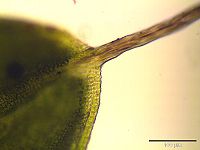Wall rotary tooth moss
| Wall rotary tooth moss | ||||||||||||
|---|---|---|---|---|---|---|---|---|---|---|---|---|

Wall-toothed moss ( Tortula muralis ) |
||||||||||||
| Systematics | ||||||||||||
|
||||||||||||
| Scientific name | ||||||||||||
| Tortula muralis | ||||||||||||
| Hedw. |
The wall-rotation tooth moss ( Tortula muralis ) is probably the most common moss on walls and stones in the inner cities.
features
It forms low cushions approx. 5 mm high. When wet, it is yellowish green. When dry, the leaves appear blackish. The long white hair on the tips of the leaves gives the pillows a blackish-grayish color. The stems have a dense rhizoid enfilz.
The lower leaves are smaller than the upper ones, so that there is a small rosette at the end of the stem. The shape of the leaves is tongue-shaped. The midrib emerges as long hair without chlorophyll . The leaf margins are rolled up.
The almost always numerous capsules stand upright on a 1–2 cm long seta . In shape they are long cylindrical, sometimes a little curved. The peristome teeth are twisted 2 to 3 times to the left. The seta is yellowish at first and then turns dark purple to brown with age.
The roof-toothed moss ( Tortula ruralis ) belongs to the same genus . Of course, this occurs primarily on rocks and earth , but also colonizes walls, concrete and roofs. It is seldom found even on dead wood or on bark. It forms stems that can be up to 8 cm high. Usually, however, these only reach a height of about 2 to 4 cm.
The wall-toothed moss ( Tortula muralis ) on the long seta and the yellow-green color when wet is easy to distinguish from the wall moss, cushion moss ( Grimmia pulvinata ), which is also common in city centers .
Occurrence
Previously, Tortula muralis a Moos of limestone rocks. Today you can find it practically anywhere there are walls, concrete surfaces, gravestones, etc. It grows on both horizontal and vertical surfaces and, among the mosses that populate walls in inner cities, is the one that prefers the driest locations.
It occurs all over the world today.
literature
- Jan-Peter Frahm , Wolfgang Frey : Moosflora (= UTB . 1250). 4th, revised and expanded edition. Ulmer, Stuttgart 2004, ISBN 3-8252-1250-5 .
- Radosław Walkowiak, Akira Takeuchi: Short Notes of Tortula muralis . CTC 2019



